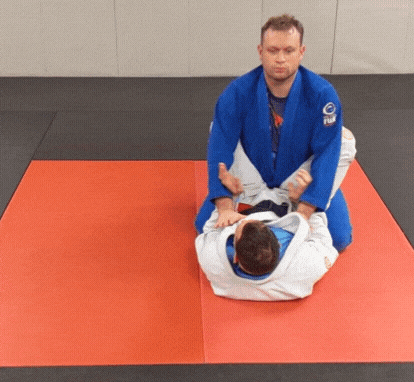The Williams Guard
Named after Sean Williams, the Williams guard is a form of full guard which is sort of a proto-rubber guard. When played correctly, the guard is very stable defensively and offers many offensive options. Guards of this nature often appeal to newer grapplers because they place more emphasis on sequence than timing. They are kind of a ‘paint by numbers’ approach to grappling. Let’s take a look.
The main goal of Williams guard is to do two things simultaneously, control posture and win angle. To a certain degree this can be said of most guards, but it is clearly on display in this case. To begin, we must break our opponents' posture. FIrst, we clear any frames or posts they may have, then win a strong grip on the back of the neck. From here, we hip out to one side and bring one of our legs high onto their back. Next we open our grip, being sure to keep one hand pulling down on their head to maintain posture control, and underhook our own thigh. Taking a gable grip, we then circle our forearm to the other side of their head and up under their jaw line. This forearm can be useful for maintaining the angle we won earlier. From this position, we are emphasising pressure down on the shoulder and attempting to prevent them from squaring back up to us. It is very important that our other leg remain active, hugging tight and not lazily lying on the mat. Once our position is established we look to see how our opponent reacts.There are a few things they can do to stay safe, one of which is to make sure the trapped arm is pointed up at our head and not down at our feet.
Entering the Williams Guard
The Kimura
If they are asleep at the wheel and the trapped arm is lazy or in fact pointed down at our feet, the Kimura is the easiest attack. Keeping heavy pressure on the shoulder, we can switch our hands so that our inside arm reaches up under our thigh and holds it in place, freeing our outside arm to reach down and win their wrist. It may be possible to finish this kimura without the figure four just by driving the wrist upward, but if not, it is easy to move the thigh momentarily and secure the figure four grip. Once we have it, we want to make sure we are squeezing our knees together and not just rotating the arm but also pulling the elbow toward us to make it as tight as possible.
Kimura from Williams Guard
The triangle
A common response from the top player is to post up on their free arm and attempt to drive themselves back to square. Their posting on this arm will create space for us to hit the triangle. In order To free our leg without being extremely flexible, it is helpful to first draw the knee up inside their bicep, then shrimp again back toward the trapped arm. From here it should be much easier to get the leg over the shoulder and cross our ankles. That said, we will come into this triangle at the extreme opposite of where we need to be to finish it, so we will need to correct the angle. We do not want to lose control of their posture while we do this so it is important to reach up and grab our shin to hold them in place when we open our legs to be able to shrimp. My preference is for the ‘right then left’ grip sequence below. Once we have shrimped out we want to secure an underhook on either the arm or the leg to hold the angle in place. Remember, when locking a triangle we want only their arm and their neck inside our legs, not the shoulder. Make this adjustment with your hand before locking.
Triangle from Williams Guard
The armbar
Another response the top player may have is to attempt to grip our jacket with their free arm and pull themselves back to square, or they may simply have post the arm on the mat in a position that makes it difficult for us to clear our leg out for the triangle but is close enough for us to win a wrist grip on. In either case we begin as before, shrimping to win an extreme “looking in their ear” angle. This time however, when adjusting our free leg, the goal is to scoop their far arm up with the top of our thigh and bring it toward us. At the same time our free hand should win their wrist and pull it toward our head. From here we bring our free leg over their head, doing our best to keep everything tight. Remember when placing our second leg we want our calf on the back of their head, not on the back of their neck, but don’t forget to squeeze. Your knees should be together with one foot flared out to the side like you are doing the Charleston. This grip makes it much harder to posture up and extract the arm. If you don’t know how to do the Charleston, well then maybe grappling just isn't for you.
Armbar from Williams Guard
Proper Armbar Technique
The Omoplata
This is in many way the most important attack from the Williams guard. It’s also in many ways the easiest. Because we have already won so much angle, and because we already have our thigh so high up on the shoulder, we have done most of the heavy lifting. All that is needed is to free the far leg completely and continue to bring our head toward their feet. Be sure to secure their back, belt, or leg as quickly as possible to prevent them from doing a front roll out of our attack. Keep in mind it is better to move your hips and have your feet follow than to lead with the foot and hope to be able to move your hips after.
If we cannot free our far leg from beneath them this attack will not be an option. Driving their head up and away with our forearm or even with the palm of our free hand can be helpful sometimes if they are refusing to make the space we need.
Omoplata from Williams Guard
Although the Omoplata is the most obvious attack from our guard, it is not always the easiest finish to secure, especially on larger opponents. As a result many people prefer to use it as a position to sweep from or check down to other finishing options. More on the sweep and subsequent top side follow ups in the next post but for now, here are some alternative finishes.
Toe hold.
Upon securing the Omoplata position, our opponent will most likely be kneeling. If they were on their belly instead, the shoulder lock would be easy and there would be no need to change tact. Being on their knees however, gives them more leverage to resist, but leaves their feet within reach. With our inside hand, we want to reach back and cover their pinky toe with the largest knuckle of our middle finger. Our outside hand then reaches over then under the leg to grip our own wrist. Hugging the leg tight, we attempt to do an abdominal crunch, forcing our opponents big toe… well… up their butt. There is no better way to say it. Keep in mind you do not want to extend your arms away from your body, instead you want to hug the ankle tight and power the move with your core.
Omoplata from Williams Guard with Toe Hold
Kneebar
When we move our grip from their back to their leg they may feel they have the ability to roll free of our shoulder lock. We can choose to follow them up in their roll and take a top side position, or we can let them roll independent of us and attack a kneebar instead. To do so when they roll, we want to find the crest of their hip with the top of our inside foot, the one that was over their shoulder in the omoplata. Our outside leg will then wrap around the thigh and stomp on the groin of their other leg. Squeezing here will give us reasonable control. As with all kneebars the most important thing is to control the foot properly. We want their big toe to be trapped against our neck, not their pinky toe. This can’t be emphasized enough. When further bolstered with a grip on the heel, we should be able to prevent the leg from rotating out of our attack. At this point we may choose to switch our top leg to match with the bottom for extra leverage.
Omoplata from Williams Guard with Kneebar
Passing the Williams Guard.
In order to apply the Sao Paulo pass against the closed guard we must first have two things; and underhook and our head on the opposite side. The nature of the Williams guard is that it gives the top player both of those things. The fight then becomes about the low leg. Although all the fancy stuff happens with the high leg, the real fight is for the low leg. As a passer our goal is to step over the low leg, but to do so safely. The first step is to make sure our underhook is pointed up toward their head, ideally with a good grip on the gi. Next our free hand needs to win a grip on the gi of the near elbow. It is important when fighting for this grip that we do not allow them to re grip us, or they will be able to set up their armbar as above. Our grip on their elbow should help to limit their ability to rotate away from us for the Omoplata etc. Keeping this grip we then use our body to bring their free leg toward the mat where we look to trap it under our own elbow. Pinning their leg in place,we walk our hips back again until we have space to switch our hips and step over their leg with our far leg, not our near leg. This ensures we will pass directly to side control and not get caught in half guard. It is important during the whole process to be wary of collar grips as we don’t want to pass directly into any chokes.
Sao Paulo pass against the Williams Guard











